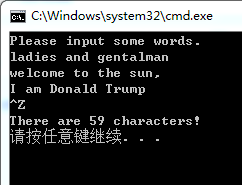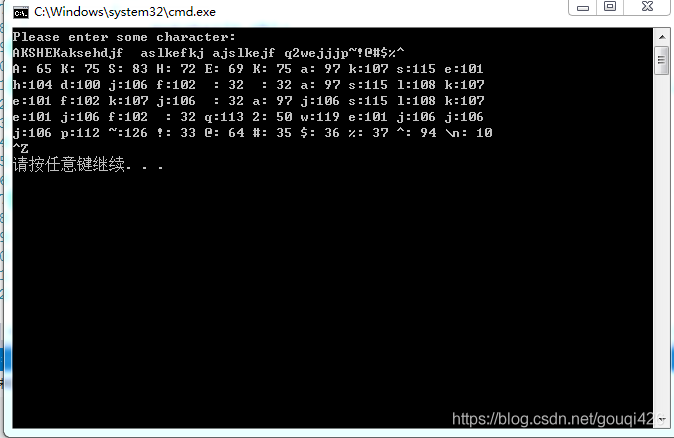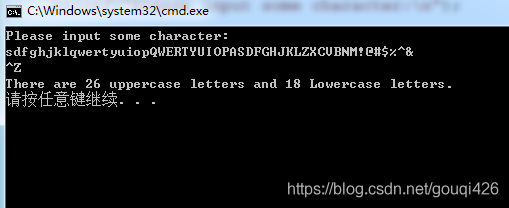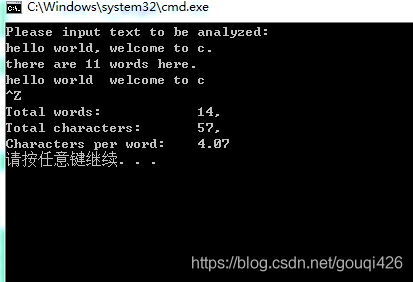C prime plus 第六版 課後程式設計練習 第8章
C prime plus 第六版 課後程式設計練習 第8章
- 8.11.1.設計一個程式,統計在讀到檔案結尾之前讀取的字元數。
- 8.11.2 編寫一個程式,在遇到 EOF 之前,把輸入作爲字元流讀取。程式要列印每個輸入的字元及其相應的ASCII十進制值。注意,在ASCII序列中,空格字元前面的字元都是非列印字元,要特殊處理這些字元。如果非列印字元是換行符或製表符,則分別列印\n或\t。否則,使用控制字元表示法。例如,ASCII的1是Ctrl+A,可顯示爲^A。注意,A的ASCII值是Ctrl+A的值加上64。其他非列印字元也有類似的關係。除每次遇到換行符列印新的一行之外,每行列印10對值。(注意:不同的操作系統其控制字元可能不同。)
- 8.11.3.編寫一個程式,在遇到 EOF 之前,把輸入作爲字元流讀取。該程式要報告輸入中的大寫字母和小寫字母的個數。假設大小寫字母數值是連續的。或者使用ctype.h庫中合適的分類函數更方便。
- 4.編寫一個程式,在遇到EOF之前,把輸入作爲字元流讀取。該程式要報告平均每個單詞的字母數。不要把空白統計爲單詞的字母。實際上,標點符號也不應該統計,但是現在暫時不同考慮這麼多(如果你比較在意這點,考慮使用ctype.h系列中的ispunct()函數)。
- 8.11.5.修改程式清單8.4的猜數位程式,使用更智慧的猜測策略。例如,程式最初猜50,詢問使用者是猜大了、猜小了還是猜對了。如果猜小了,那麼下一次猜測的值應是50和100中值,也就是75。如果這次猜大了,那麼下一次猜測的值應是50和75的中值,等等。使用二分查詢(binary search)策略,如果使用者沒有欺騙程式,那麼程式很快就會猜到正確的答案。
- 8.11.6 修改程式清單8.8中的get_first()函數,讓該函數返回讀取的第1個非空白字元,並在一個簡單的程式中測試。
- 8.11.7修改第7章的程式設計練習8,用字元代替數位標記選單的選項。用q代替5作爲結束輸入的標記。
- 8.11.88.編寫一個程式,顯示一個提供加法、減法、乘法、除法的選單。獲得使用者選擇的選項後,程式提示使用者輸入兩個數位,然後執行使用者剛纔選擇的操作。該程式只接受選單提供的選項。程式使用float型別的變數儲存使用者輸入的數位,如果使用者輸入失敗,則允許再次輸入。進行除法運算時,如果使用者輸入0作爲第2個數(除數),程式應提示使用者重新輸入一個新值。該程式的一個執行範例如下:
電子版C primer plus 第6版 中文文字版下載地址
https://blog.csdn.net/gouqi426/article/details/106412212
以下爲課後練習。
使用編譯器 vs 2013 。
如使用其他編譯器,可將scanf_s()修改爲scanf(),同時刪除sizeof()。具體原因請學習scanf_s()和scanf()的區別。
下面 下麪的一些程式要求輸入以EOF終止。如果你的操作系統很難或根本無法使用重定向,請使用一些其他的測試來終止輸入,如讀到&字元時停止。
8.11.1.設計一個程式,統計在讀到檔案結尾之前讀取的字元數。
EOF相關知識見課本8.3.2 第220頁。EOF定義在stdio.h中,返回值爲-1.
getchar()函數返回值通常介於0-127,擴充套件字元集爲0-255,無論哪種情況,-1都不對應任何字元,所以EOF可以用於標記檔案結尾。
// 8.11.1 統計字元數.cpp : 定義控制檯應用程式的入口點。
#include "stdafx.h"
int _tmain()
{
char ch;
int i_count = 0; //計數器
printf("Please input some words.\n");
while ((ch = getchar()) != EOF)
i_count++;
printf("There are %d characters!\n", i_count);
return 0;
}

8.11.2 編寫一個程式,在遇到 EOF 之前,把輸入作爲字元流讀取。程式要列印每個輸入的字元及其相應的ASCII十進制值。注意,在ASCII序列中,空格字元前面的字元都是非列印字元,要特殊處理這些字元。如果非列印字元是換行符或製表符,則分別列印\n或\t。否則,使用控制字元表示法。例如,ASCII的1是Ctrl+A,可顯示爲^A。注意,A的ASCII值是Ctrl+A的值加上64。其他非列印字元也有類似的關係。除每次遇到換行符列印新的一行之外,每行列印10對值。(注意:不同的操作系統其控制字元可能不同。)
ASCII碼錶 碼表可在本網站搜尋,此處不提供。
// 8.11.2 列印字元及ASCII碼.cpp : 定義控制檯應用程式的入口點。
#include "stdafx.h"
int _tmain()
{
char c_ch = 0;
int i_char = 0; //計數器,控制每行列印個數
printf("Please enter some character:\n");
while ((c_ch = getchar()) != EOF) //輸入的不爲EOF,則進入回圈
{
i_char++; //每讀取一個字元 計數器加1
if (c_ch < ' ') //在ASCII序列中,空格字元前面的字元都是非列印字元,此分支處置非列印字元
{
if (c_ch == '\t') //
{
putchar('\\');
putchar('t');
printf(":%3d ", c_ch); //列印ascii碼,%3d中的3用途是控制字長爲3位數,可以保證對齊,增加美觀。
}
else if (c_ch == '\n')
{
putchar('\\');
putchar('n');
printf(":%3d ", c_ch);
}
else
{
putchar('^');
putchar(c_ch + 64);
printf(":%3d ", c_ch);
}
}
else
{
putchar(c_ch);
printf(":%3d ", c_ch);
}
if (i_char % 10 == 0) //每行列印10對,強制換行。
{
printf("\n");
}
}
return 0;
}

8.11.3.編寫一個程式,在遇到 EOF 之前,把輸入作爲字元流讀取。該程式要報告輸入中的大寫字母和小寫字母的個數。假設大小寫字母數值是連續的。或者使用ctype.h庫中合適的分類函數更方便。
ctype.h相關內容見教材7.2.2
// 8.11.3 字母個數.cpp : 定義控制檯應用程式的入口點。
#include "stdafx.h"
#include <ctype.h>
int _tmain()
{
char c_ch;
int i_low = 0;
int i_cap = 0;
printf("Please input some character:\n");
while ((c_ch =getchar())!=EOF)
{
if (islower(c_ch))
i_low++;
else if (isupper(c_ch))
i_cap++;
}
printf("There are %d uppercase letters and %d Lowercase letters.\n", i_cap, i_low);
return 0;
}

4.編寫一個程式,在遇到EOF之前,把輸入作爲字元流讀取。該程式要報告平均每個單詞的字母數。不要把空白統計爲單詞的字母。實際上,標點符號也不應該統計,但是現在暫時不同考慮這麼多(如果你比較在意這點,考慮使用ctype.h系列中的ispunct()函數)。
可以參考教材7.4 中的程式清單7.7
需要注意解決的幾個問題
- 輸入開頭爲非字母字元,如空格、標點符號,數位等
- 單詞中間存在連續空格或非字母字元
- 阿拉伯數位如何處理。
// 8.11.4 平均字母數.cpp : 定義控制檯應用程式的入口點。
#include "stdafx.h"
#include <ctype.h>
int _tmain()
{
char c_ch; //讀入的字元
char c_prev=' '; //讀入的前一個字元
int i_word = 0; //單詞數
int i_alph = 0; //總字母數
double d_avrg = 0.0; //平均數
printf("Please input text to be analyzed:\n");
while (c_ch = getchar()) //清理輸入開頭處的非字母字元,如空格、標點等
{
if (isalpha(c_ch)) //如果字元爲字母則跳出回圈,到下一步,不是則繼續回圈至爲字母
break;
}
while (c_ch != EOF)
{
if (isalpha(c_ch)) //本字元爲字母,字母數加1
{
i_alph++;
}
else if (isspace(c_ch)) // 本字元是空格
{
;
}
c_prev = c_ch; //將本字元賦值給前字元後繼續處理字元流
c_ch = getchar();
if (!isalpha(c_ch) && isalpha(c_prev)) //本字元不是字母,前字元是字母
{
i_word++; //單詞數加1
}
}
d_avrg = (double)i_alph / i_word;
printf("Total words:\t\t%d,\nTotal characters:\t%d,\nCharacters per word:\t%.2lf\n", i_word, i_alph, d_avrg);
}

8.11.5.修改程式清單8.4的猜數位程式,使用更智慧的猜測策略。例如,程式最初猜50,詢問使用者是猜大了、猜小了還是猜對了。如果猜小了,那麼下一次猜測的值應是50和100中值,也就是75。如果這次猜大了,那麼下一次猜測的值應是50和75的中值,等等。使用二分查詢(binary search)策略,如果使用者沒有欺騙程式,那麼程式很快就會猜到正確的答案。
// 8.11.5 猜數位.cpp : 定義控制檯應用程式的入口點。
#include "stdafx.h"
#include <ctype.h>
int _tmain()
{
char c_chyn; //讀取Y/N輸入
char c_chbs; //讀取B/S輸入
int i_upper = 100; //上限
int i_lower = 0; //下限
int i_guess = 50; //初值
printf("Pick an integer from 1 to 100. I will try to guess ");
printf("it.\nRespond with a y or Y if my guess is right and with");
printf("\nan n or N if it is wrong.\n");
printf("Uh...is your number %d (Y/N)?\n", i_guess);
scanf_s("%c", &c_chyn,1);
c_chyn = toupper(c_chyn);
getchar();
//printf("%c\n",c_chyn); //覈對輸入數據
while (c_chyn != 'Y') // 獲取響應,與 Y 做對比
{
printf("Well,the number you chosen is bigger or smaller than I guess?(B/S)\n");
scanf_s("%c", &c_chbs,1);
c_chbs = toupper(c_chbs);
getchar();
if (c_chbs == 'B')
{
i_lower = i_guess;
i_guess = (i_lower + i_upper) / 2;
}
else
{
i_upper = i_guess;
i_guess = (i_lower + i_upper) / 2;
}
printf("Uh...is your number %d, (Y/N)?\n", i_guess);
scanf_s("%c", &c_chyn,1);
c_chyn = toupper(c_chyn);
getchar();
}
printf("I knew I could do it!\n");
return 0;
}


8.11.6 修改程式清單8.8中的get_first()函數,讓該函數返回讀取的第1個非空白字元,並在一個簡單的程式中測試。
// 8.11.6 返回非空白字元.cpp : 定義控制檯應用程式的入口點。
#include "stdafx.h"
#include <ctype.h>
char get_choice(void);
char get_first(void);
int get_int(void);
void count(void);
int _tmain()
{
int choice;
void count(void);
while ((choice = get_choice()) != 'q')
{
switch (choice)
{
case 'a': printf("Buy low, sell high.\n");
break;
case 'b': putchar('\a'); /* ANSI */
break;
case 'c': count();
break;
default: printf("Program error!\n");
break;
}
}
printf("Bye.\n");
return 0;
}
void count(void)
{
int n, i;
printf("Count how far? Enter an integer:\n");
n = get_int();
for (i = 1; i <= n; i++)
printf("%d\n", i);
while (getchar() != '\n')
continue;
}
char get_choice(void)
{
int ch;
printf("Enter the letter of your choice:\n");
printf("a. advice b. bell\n");
printf("c. count q. quit\n");
ch = get_first();
while ((ch < 'a' || ch > 'c') && ch != 'q')
{
printf("Please respond with a, b, c, or q.\n");
ch = get_first();
}
return ch;
}
char get_first(void)
{
int ch;
while (!isalpha(ch = getchar()))
{
continue;
}
return ch;
}
int get_int(void)
{
int input;
char ch;
while (scanf_s("%d", &input,sizeof(input)) != 1)
{
while ((ch = getchar()) != '\n')
putchar(ch); // 處理錯誤輸出
printf(" is not an integer.\nPlease enter an ");
printf("integer value, such as 25, -178, or 3: ");
}
return input;
}
8.11.7修改第7章的程式設計練習8,用字元代替數位標記選單的選項。用q代替5作爲結束輸入的標記。
// 8.11.7 字元代替數位標記選單選項.cpp : 定義控制檯應用程式的入口點。
/*
7.12.8.修改練習7的假設a,讓程式可以給出一個供選擇的工資等級選單。使用switch完成工資等級選擇。執行程式後,顯示的選單應該類似這樣:**************************************************************
Enter the number corresponding to the desired pay rate or action:
1) $8.75/hr 2) $9.33/hr
3) $10.00/hr 4) $11.20/hr
5) quit
**************************************************************
如果選擇 1~4 其中的一個數字,程式應該詢問使用者工作的小時數。程式要通過回圈執行,除非使用者輸入 5。如果輸入 1~5 以外的數位,程式應提醒使用者輸入正確的選項,然後再重複顯示選單提示使用者輸入。使用#define建立符號常數表示各工資等級和稅率。
*/
#include "stdafx.h"
#include <ctype.h>
#define BSTIME 40
#define MTP 1.5
#define RATE1 0.15
#define RATE2 0.20
#define RATE3 0.25
#define LINE1 300
#define LINE2 150
#define INCOME_PER_HR1 8.75
#define INCOME_PER_HR2 9.33
#define INCOME_PER_HR3 10.00
#define INCOME_PER_HR4 11.20
int _tmain()
{
double d_wktime = 0;
double d_money_t = 0;
double d_money_l = 0;
double d_tax = 0;
double INCOME_PER_HR = 0;
int i_chs = 0;
int i_count;
for (i_count = 0; i_count <= 65; i_count++)
{
putchar('*');
}
printf("\nEnter the letter corresponding to the desired pay rate or action:\n");
printf("a) $8.75/hr\tb) $9.33/hr\n");
printf("c) $10.00/hr\td) $11.20/hr\n");
printf("q) quit\n");
for (i_count = 0; i_count <= 65; i_count++)
{
putchar('*');
}
printf("\n");
i_chs=getchar();
while (isalpha(i_chs))
{
switch (i_chs)
{
case 'a':
INCOME_PER_HR = INCOME_PER_HR1;
break;
case 'b':
INCOME_PER_HR = INCOME_PER_HR2;
break;
case 'c':
INCOME_PER_HR = INCOME_PER_HR3;
break;
case 'd':
INCOME_PER_HR = INCOME_PER_HR4;
break;
}
if (i_chs == 'a' || i_chs == 'b' || i_chs == 'c' || i_chs == 'd')
{
printf("Your desired pay rate is $ %.2f/hr.\n", INCOME_PER_HR);
printf("Please enter how long you work perweek:\n");
scanf_s("%lf", &d_wktime, 3);
getchar();
if (d_wktime <= BSTIME)
d_money_t = d_wktime*INCOME_PER_HR;
else
d_money_t = BSTIME*INCOME_PER_HR + (d_wktime - BSTIME)*MTP*INCOME_PER_HR;
if (d_money_l <= LINE1)
d_tax = d_money_t*RATE1;
else if (d_money_t <= (LINE2 + LINE1))
d_tax = LINE1*RATE1 + (d_money_t - LINE1)*RATE2;
else
d_tax = LINE1*RATE1 + LINE2*RATE2 + (d_money_t - LINE1 - LINE2)*RATE3;
d_money_l = d_money_t - d_tax;
printf("Total income \t%.2f $ \nTax \t\t%.2f $ \nNet income \t%.2f $.\n", d_money_t, d_tax, d_money_l);
i_chs = getchar();
}
else if (i_chs == 'q') //輸入5跳出回圈
break;
else
printf("Incorrect input,please choose an option above!\n");
continue;
}
printf("BYE.\n");
return 0;
}
8.11.88.編寫一個程式,顯示一個提供加法、減法、乘法、除法的選單。獲得使用者選擇的選項後,程式提示使用者輸入兩個數位,然後執行使用者剛纔選擇的操作。該程式只接受選單提供的選項。程式使用float型別的變數儲存使用者輸入的數位,如果使用者輸入失敗,則允許再次輸入。進行除法運算時,如果使用者輸入0作爲第2個數(除數),程式應提示使用者重新輸入一個新值。該程式的一個執行範例如下:
Enter the operation of your choice:
a. add s. subtract
m. multiply d. divide
q. quit
a
Enter first number: 22.4
Enter second number: one
one is not an number.
Please enter a number, such as 2.5, -1.78E8, or 3: 1
22.4 + 1 = 23.4
Enter the operation of your choice:
a. add s. subtract
m. multiply d. divide
q. quit
d
Enter first number: 18.4
Enter second number: 0
Enter a number other than 0: 0.2
18.4 / 0.2 = 92
Enter the operation of your choice:
a. add s. subtract
m. multiply d. divide
q. quit
q
Bye.
// 8.11.8 加減乘除.cpp : 定義控制檯應用程式的入口點。
#include "stdafx.h"
//#include <ctype.h>
char choose(void);
float number(void);
float add(float a, float b);
float multip(float a, float b);
float subtr(float a, float b);
float divide(float a, float b);
int _tmain(void)
{
float f_num1 = 0; //輸入的第一個數位
float f_num2 = 0; //輸入的第2個數字
float f_result = 0; //計算結果
char c_chos = 0;
char c_calc = 0; //運算子
while ((c_chos = choose()) != 'q')
{
printf("Enter first number:");
f_num1 = number();
printf("Enter second number:");
f_num2 = number();
switch (c_chos)
{
case 'a':
f_result = add(f_num1, f_num2);
c_calc = '+';
break;
case 'm':
f_result = multip(f_num1, f_num2);
c_calc = '*';
break;
case 's':
f_result = subtr(f_num1, f_num2);
c_calc = '-';
break;
case 'd':
if (f_num2 == 0) //處理除數爲0的情況,數學規則,除數不能爲0
{
printf("Enter a number other than 0:");
scanf_s("%f", &f_num2, sizeof(f_num2));
}
f_result = divide(f_num1, f_num2);
c_calc = '/';
break;
}
printf("%.1f %c %.1f = %.1f.\n\n", f_num1, c_calc,f_num2, f_result); //爲了輸出結果更直觀,有區分,此處使用2個換行符,增加一行空行
while (getchar() != '\n');
}
printf("Bye!\n");
return 0;
}
char choose(void) //選擇函數,從5個選項中進行選擇,5個以外的其他選項進行提示重選
{
char chos;
printf("Enter the operation of your choose:\n");
printf("a.add \t\t s.subtract\n"); //使用製表符對齊
printf("m.multiply \t d.divide\n");
printf("q.quit\n");
while ((chos = getchar()) && chos != 'a' && chos != 'm' && chos != 's' && chos != 'd' && chos != 'q')
{
printf("Please enter again, enter a, m, s, d or q:");
while (getchar() != '\n');
}
return chos;
}
float number(void)
{
float f_num;
char num;
while (scanf_s("%f", &f_num, sizeof(f_num)) != 1) //當輸入非數位時,scanf_s()不會讀取,會放在輸入快取等待讀取,就可以用下面 下麪的getchar來讀取這個字元
{
while ((num = getchar()) != '\n')
putchar(num);
printf(" is not an number.\n");
printf("Please enter a number, such as 2.5, -1.78E8, or 3:");
}
return f_num;
}
float add(float a, float b)
{
float sum;
sum = a + b;
return sum;
}
float multip(float a, float b)
{
float multi;
multi = a * b;
return multi;
}
float subtr(float a, float b)
{
float sub;
sub = a - b;
return sub;
}
float divide(float a, float b)
{
float div;
div = a / b;
return div;
}
程式碼執行結果與範例基本一致,存在的問題是,因要求輸入數位爲float,故在列印時,即便輸入爲整數,列印也帶小數,無法做到與範例完全一致。